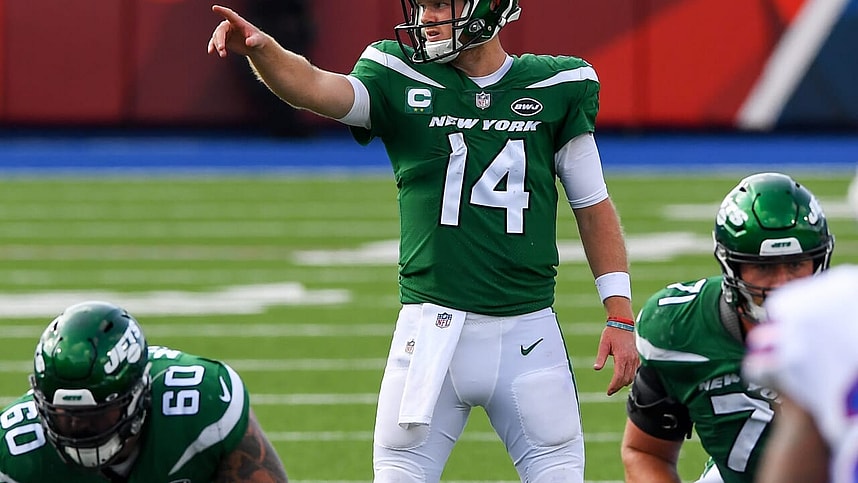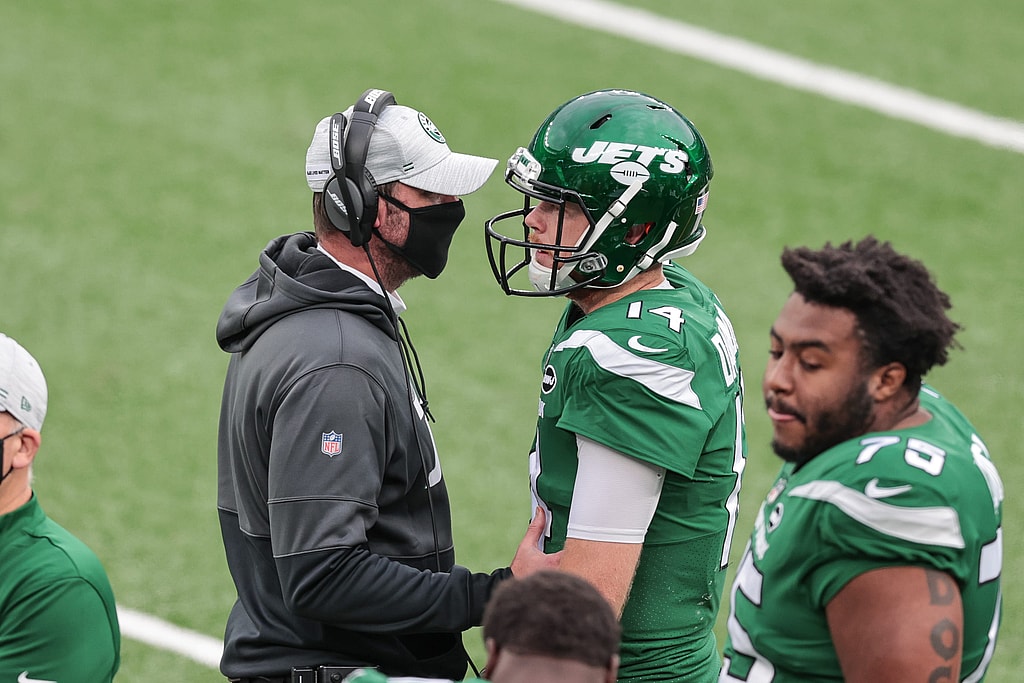
Adam Gase is far from innocent, but he’s not the primary reason why the New York Jets’ Sam Darnold era didn’t work out.
Sam Darnold with the KEEPER. @Panthers take the lead!
?: #CARvsHOU on @NFLNetwork
?: https://t.co/12dXbqaBVJ pic.twitter.com/8QFoT6pFlN— NFL (@NFL) September 24, 2021
There’s no use in crying about the past, especially when the prior affairs are only three weeks old. But social media’s stranglehold on society and the NFL stretching its news cycle from eight hours on Sunday to 365 days a year have seemingly done away with rationality.
If invitations to Canton were granted through 280 characters or less, for example, the construction of Sam Darnold’s bust would not only be underway but his 2021 season might have its own wing. It’s easy to see why Darnold’s modern endeavors have earned their share of headlines: he’s the quarterback of one of five undefeated NFL teams and his redemption story is compounded by the fact his former employers, the New York Jets, serve as a running gag amongst professional and amateur football comedians alike.
The Jets’ reunion with Darnold was crossed off of their bucket list on kickoff weekend. It’s way too early to fully grade the trade that sent Darnold to Charlotte, especially considering two of the metropolitan spoils garnered (second and fifth-round picks next spring) don’t even have names yet. Realistically, the Jets shouldn’t worry about Darnold again until 2025, the next scheduled meeting between Gang Green and Carolina.
Yet, the omnipotent nature of modern NFL football doesn’t allow the Jets a moment’s peace (Carolina’s nationally televised win over Houston on Thursday hasn’t helped stop the spread). The fact that Darnold is playing an active role in the Panthers’ success…he’s responsible for six of Carolina’s eight touchdowns while the Jets have scored two over their first three games under Zach Wilson’s offensive watch…is placing only a bigger spotlight on both Gang Green’s past, present, and future blueprints.
As their team continues to sputter sans Sam, Jets fans have sought a main villain, a living, breathing entity whom they can blame for their predicaments. Former head coach Adam Gase has been the primary target as Darnold joins a list of breakthrough stars that have flourished upon his departure (joining names like Ryan Tannehill, Jarvis Landry, and Laremy Tunsil).
Such fingering is misdirected.
The Jets’ modern struggles obviously do not fully exonerate Gase. Surely the post-Gase success list (which has also welcomed the fortunes of Gase’s collegiate and professional teams) isn’t a matter of coincidence and, traumatizing as this season has been so far, his weekly denials that he was fighting with the faces of the franchise haven’t been missed. Besides, the obvious suspect, as so many other murder mysteries have proven before, is more often than not the one who did the deed.
Gase will require some extra supervision when he inevitably gets yet another NFL job (because the modern NFL loves, if anything, coaching retreads), but he’s shielding the real culprit: it was ex-general manager Mike Maccagnan, in the front office, with a misguided sense of roster management.

 Mandatory Credit: Trevor Ruszkowski-USA TODAY Sports
The jury is still out on Maccagnan’s successor Joe Douglas, especially with the poor early returns of the Wilson/Robert Saleh era. But one thing Saleh knew what Maccagnan was doing wasn’t working: as of Sunday’s Week 3 contest (a garish 26-0 loss in Denver), only three players from Maccagnan’s last contest as the metropolitan decision-maker (Foley Fatukasi, Marcus Maye, Nathan Shepherd) remain on the modern roster. Half of Maccagnan’s ill-fated final class (in the ensuing 2019 draft) is already gone.
Douglas’ pruge of the Maccagnan is a microcosm of what Darnold had to deal with. The Maccagnan era was one of negligence and ill-advised splashes, one that tried to cover inefficiencies at the supposedly “boring” positions with high-profile signings.
From the get-go, Darold was mostly left to fend for himself. Maccagnan’s strategy seemed to be an incomplete cause-and-effect chart whose profits and yields relied on Darnold becoming an MVP candidate. The offensive cabinets assembled by Maccagnan consisted of the aforementioned big-ticket free agents equally saddled with big baggage (Le’Veon Bell) and that was just the beginning of the team’s issues.
In his all-too-brief time as the Jets’ thrower, Darnold was also stuck with first-round washouts (Breshad Perriman), former stars past their prime (Demaryius Thomas, Frank Gore), flash-in-the-pan breakthrough candidates that wilted under a brighter spotlight (Chris Herndon, Quincy Enunwa), and undeveloped projects that either didn’t work out (Terrelle Pryor, Jermaine Kearse) or remain a work in progress (Braxton Berrios, Denzel Mims).
304 yards in the air, 2 TDs on the ground for Sam Darnold last night. #CARvsHOU pic.twitter.com/B4BQCdHbfJ
— NFL (@NFL) September 24, 2021
All the while, Maccagnan almost completely ignored construction of the wall in front of Darnold. Save for some desperate moves late in his tenure…the ill-fated trade for Kelechi Osemele and drafting Chuma Edoga in the third round of his final draft…Maccagnan opted to go with blockers made of inconsistent one-year failed fixes. Darnold, for example, worked with three different primary centers (Spencer Long, Jonotthan Harrison, and Connor McGovern), an inconsistency set forth by Maccagnan’s failure to find a long-term solution.
It was a stark departure from predecessor Mike Tannenbaum’s finest hours: during his first draft in 2006, Tannenbaum chose Virginia tackle D’Brickashaw Ferguson, passing (pun intended) on touted quarterback prospects like Vince Young and Jay Cutler. When they had a chance to take touted collegiate, skill player heroes like Joseph Addai, Sinorice Moss, and LenDale White, they instead opted to bring in Nick Mangold. Not only did those two blockers headline the closest things the Jets have had to recent glory days, but they also became two of the most beloved figures in franchise history. Tannenbaum surrounded his homegrown talents with accomplished veteran strengths like Alan Faneca and Damien Woody. Carolina had already restocked its blocking cupboard with Taylor Moton and Matt Paradis.
Compare that to what Darnold has to work with in Carolina: the Panthers found a way to unite him with Robby Anderson, one of the few things that were working with him in New York. Anderson was one of two four-digit yardage receivers Darnold now has to throw to, the other being DJ Moore. Of course, no one in Jets circles needs to be reminded about the impact Christian McCaffrey can have, as the returning running back served as the 187-yard difference in Carolina’s 19-14 triumph on opening weekend. Carolina’s defense has also come up huge; through a majority of Week 3 action, the Panthers are the only team in the league that has let up less than 200 yards a game (191).
Rather than the hapless Gase, Darnold is also working with accomplished offensive minds Matt Rhule and Joe Brady. The former is all too familiar with raising lost causes from the football abyss, taking downtrodden college programs at Temple and Baylor to unprecedented new heights.
Carolina is in the midst of working with a new general manager, having brought in former Seattle scouting expert Scott Fitterer last winter. Adding Darnold is by far his most impactful move to date, a trade that open a new chapter in the book of the Panthers, one that officially allowed them to move on from the Cam Newton/Ron Rivera glory days.

Mandatory Credit: Vincent Carchietta-USA TODAY Sports
Just a few months into the job, Fitterer has done more Darnold than Maccagnan ever did.
Darnold is no longer being relied upon to be the sole source of offensive sparks. Many of those pieces arrived before Fitterer, but also spent valuable offseason funds on the aforementioned defense: former Temple linebacker was reunited with Rhule and now leads the team in sacks (4.5). They used their first pick on South Carolina shutdown corner Jaycee Horn (though he’s set to miss some time due to a non-contact foot injury). The Panthers are only poised to upgrade further after Week 3’s events: according to NFL Network’s Ian Rapoport, they’re close to picking up former Jacksonville cornerback C.J. Henderson for tight end Dan Arnold and a third-round choice…a move the Jets, frankly, should’ve investigated further into.
Simply put, Fitterer appears to know the impact of surrounding a franchise quarterback with reliable help on all sides of the ball…a lesson the Jets are learning the hard way. Douglas at least appears to understand that on paper, having added accomplished veterans and using expanded draft capital on assistance in protection. There’s plenty of time to develop past the Darnold era and get things back on track. It doesn’t diminish, however, the progress Carolina has made with the former green thrower.
There’s no use in looking back on the Darnold era, at least not at this point on the NFL timeline, but that’s not the nature of modern football. If a (premature) culprit must be found, the Jets must start at the top. Blaming Gase is popular…but putting on Maccagnan is may be right for now.
Geoff Magliocchetti is on Twitter @GeoffJMagsÂ
More about: New York Jets